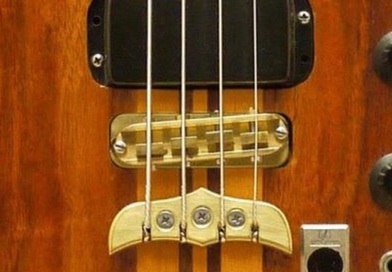What's going on with your bridge? I've been wracking my well-wracked brain to recall ever seeing an Alembic bridge canted at that angle.

I've been a guitar repairman for decades, and I'm not here to criticize or mock. Especially here, because we all come here for the same reason: to admire sheer excellence, and to learn.
Your Alembic has been injured, and you should have it healed. It was not only the finest bass on the planet in 1975, it still is! Consider this: in '75 Stanley Clarke had just begun showing the world what Alembics sounded like. I'm sure many people here can tell you how many basses Alembic made that year, without looking. But I'm guessing somewhere around thirty, which means very few bassists were lucky enough to own one.
I know, because my Alembic is a 1975 Series 1 (75-240).
So let me put my imaginary guitar CSI cap on, and I'll show you what I mean. The gap at one end of the sustain block shows that it's been replaced (either that or it shrank ). When new holes were drilled for the bridge bolts, they were placed slightly south (toward the knobs), which you can see following the string alignment from the tailpiece to the neck and comparing them with the lams. (It's easier to see in your original picture.)
Alembic uses hex-head bridge bolts:
Flathead machine screws on an Alembic are like a Formula 1 race car on bicycle wheels. They are an abomination. The upper one has clearly migrated from uppy-downy alignment with the hole, which is kinda weird when you consider that somebody went through all that trouble to slant the bridge in the first place. (What Cletus calls; ball-peen detailing.) Apparently not enough.
Now for the good news: they actually did a pretty good job, if only in not damaging your bass in any way, as far as I can tell. It takes balls the size of church bells to redesign an Alembic's bridge in the first place, much less pull the sustain block out of there without using a crowbar or something.
From another standpoint, the only reason to slant the bridge is to address temperament. If you want to put a whole party to sleep almost instantly, bring up the subject of temperament to a group of musicians. I think of it as an agreement on how many notes you can get in tune, and by how much.
Fortunately, a Swedish company called
True Temperament spent years hunched over a strobo-tuner, mapping the precise points at which upper overtones and harmonics achieved harmony with the universe or some such, uh ... time for a picture:
See that serious jag on the G string at the first fret? That gives you an idea of how far off normal frets are. Note that the only straight fret on the guitar is the one at the twelfth fret. So everything between the nut and the 12th fret is mirrored by the bridge saddles and their relation to the 12th fret. The G string saddle is always forward to shorten the length of the string, to compensate for that.
For reference, you can go through the
Alembic Featured Custom Vault and check the position of the G string saddles in relation to the others. They're all the same. With the True Temperament fingerboard as a reference, you can see why (spot any slanted bridges while you're in there?)
Jimmy Johnson has a fantastic post about temperament in
this thread. (Just scroll down to the picture of a grand piano's innards, illustrated with red lines.)
In my opinion, your bass bridge was probably involved in a hit and miss (or hit and run, I'm not sure which) attempt to address that issue.
You should return to the mothership for re-grooving. And avoid flatheads (especially the human kind).